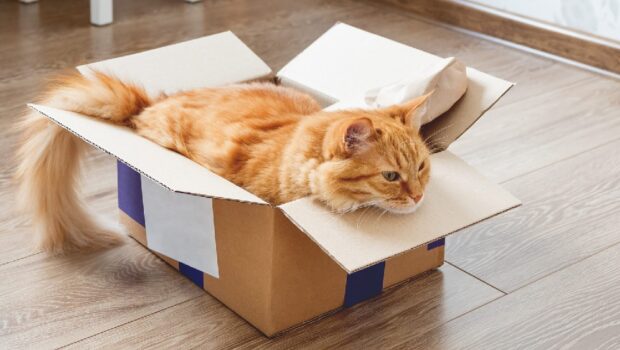Moving with pets can be a stressful experience for both pets and owners. Here are some tips to help make the transition as smooth as possible for your furry friends.
Moving with a Dog
Dogs are creatures of habit and routine, so it’s essential to stick to their daily routine of walks, food, and exercise while preparing for the move. Additionally, it’s a good idea to maintain their usual environment and not make any significant changes to their daily routine. This can help reduce stress levels and make the transition smoother.
Preparing Your Dog for the Move
If your dog doesn’t travel well, take them on car rides well before the move to help them get used to it. You can also use calming sprays, supplements or collars with pheromones to help alleviate their anxiety.
Loading the Car or Van
Dogs may become anxious and distressed when they see their belongings being moved around, so it’s best to put them in a quiet, empty room or yard. Leave some of their favourite toys and an unwashed bed to make them more comfortable. Another option is to leave your dog with a friend or family member.
New Address and Vet
Before the move, update your dog’s identification tags with your new address and phone number. This ensures that if your dog gets lost during the move, they can easily be reunited with you. It’s also important to research and find a vet in your new area in case of any emergencies.
If your dog is microchipped, change the details on it. Remember to keep the microchip information updated in case your dog goes missing.
During the Move
When it comes to moving day, make sure your dog’s belongings are one of the last things packed so that they can be as comfortable as possible. Secure your dog safely in the car using a dog guard, car harness, or travel crate on the back seat. Don’t leave your dog alone in the car with closed windows, and make plenty of stops for water, food, and toilet breaks.
If you’re travelling by air, be sure to check the airline’s pet policy and ensure your dog meets all the necessary requirements. It’s also a good idea to bring along your dog’s favourite blanket or toy to provide a sense of comfort during the flight.
Arriving at Your New Home
When you arrive at your new home, keep your dog in one room with all their belongings until your furniture arrives. Don’t wash their bedding for a while to maintain a familiar scent. Check for holes and escape routes in the garden and secure any potential hazards. Don’t be quick to clean the carpets, either.
Stick to old routines for walking and feeding. It may take some time for your dog to adjust to their new surroundings, so be patient and positive. Introduce your dog to the new area and the people living there. Take your dog for a walk and allow them to explore their new environment at their own pace.
Research Local Laws
Research local laws concerning dogs, breeds, and vaccinations. Find local parks that allow dogs and a place for your dog to run and play without a leash. Inform yourself if grass areas are sprayed against fleas and ticks.
Moving with Cats
Cats are creatures of habit and routine, too and moving can be really stressful for them. To help reduce their stress levels, choose a quiet room, like the bathroom or bedroom, and place your cat’s bed, bowls, toys, and litter tray inside a week before the move. Always place food and water in this room so the cat can get used to it.
Preparing Your Cat for the Move
On the day of the move, lock the door and close all of the windows of the room to keep the cat safe. Provide your cat with hiding places, and place familiar scents, such as blankets and toys, in the room to make them more comfortable. If possible, have a friend or family member look after your cat during the move.
Choosing the Right Carrier
When moving your cat, it’s essential to choose the right carrier. A cardboard box or plastic container may not be big enough for the cat to stretch and lie in comfortably. Cats also need access to food, water, and litter at all times, so it’s best to select a carrier that suits your pet’s needs.
Travelling with Your Cat
While driving, always place the cat carrier on the back seat of the car and never inside your car’s boot. Don’t leave your cat alone in the car, and make frequent stops for water, food, and toilet breaks. Your pet will be frightened and disoriented enough as it is, so the lack of human comfort and the darkness will just make it worse.
Arriving at Your New Home
When moving to a new house, make the cat feel like it’s in a familiar place. Doing so will help them adjust to the new environment, especially if they live in an apartment or other small living space. When unloading furniture, start with any furniture that was moved from the room where they spent their time as a house pet. If it’s not going to be put to use immediately, make sure the room is safe and secure. This will help your cat get used to the new environment without issues.
Your cat deserves to feel comfortable in their new home. To make them feel at home, you’ll need to spread their natural scents all over the house. The next time you feel like petting your pet, bring a soft cloth, lightly brush it against their face and neck, then spread this aroma throughout the house at cat height. This will allow your feline friend to believe they’re more at home.
Exploring the New Home
When you’ve completed moving into your new house, pay attention to how your pet is approaching the front door. If you see your cat approaching the door more often, then dedicate extra time to giving them the opportunity to explore what’s on the outside.
You shouldn’t force your cat out into the world before it’s ready. Wait until the morning to let your cat out. Then, after encouraging them to explore their new surroundings gently, you can let them roam free in your yard. Your cat will do best if given as much time as it needs to acclimate to new environments.
Microchip and Tags
If your pet has a microchip or a tag, ensure your home’s phone number and address are up to date, just in case your cat gets lost. It’s also important to research and find a new vet in your new area in case of any emergencies.
Final Words
In conclusion, moving with pets can be a challenging experience, but with proper planning and preparation, you can ensure that the move is as stress-free as possible for both you and your furry friends. In case you get overwhelmed – the man and van services are a call away. Contact them to make the transition to your new home a smoother one for everyone involved.





